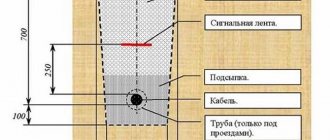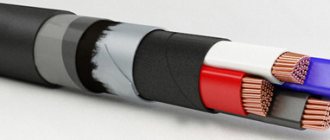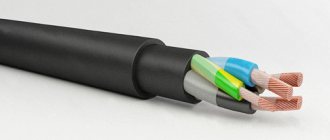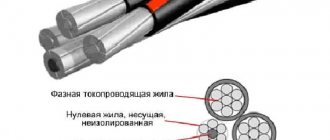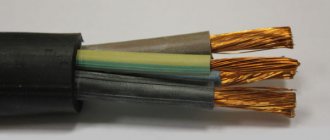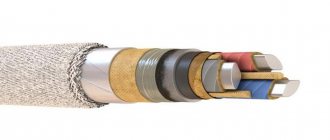Description and design of the KG cable
KG is a flexible power cable with copper conductors with insulation and a rubber sheath without protective covers (armor).
Explanation of the designation:
"K" - cable; "G" - flexible.
The most common KG cables are in the usual version with one, two or three main conductors and three main conductors and a grounding conductor (the so-called “three plus”).
To the designation of a KG cable in a tropical version, add the letter “T” through a hyphen (example: KG-T), for a cable in a cold-resistant version – add the letters “HL” through a hyphen (example: KG-HL).
The letter “n” is added to the designation of cables with a neutral conductor (example: KGn), the letter “v” is added to the designation of cables with one or two auxiliary conductors (without grounding and neutral conductors) (example: KGv).
Example of designation: KGn - KHL 2x25+ 1x16 - KG cable with a zero core in the “HL” version with two main cores with a cross-section of 25 mm2.
Since KG cables are intended for intensive operation in a wide temperature range, the technical specifications establish requirements for structural, electrical and mechanical parameters for both new cables and limit standards for cables during operation.
KG cables can have from one to five cores with a cross-section from 0.75 mm2 to 120 mm2.
The range of cross-sections of the main cores depending on the total number of cores is shown in the table.
| Number of cores | Nominal cross-section, mm 2 | ||
| Main | Neutral or ground | Auxiliary | |
| 1 | — | — | 2,5-120 |
| 2 and 3 | — | — | 0,75 – 120 |
| 2 and 3 | 1 | — | |
| 2 and 3 | — | — | 2,5 – 70 |
| 2 and 3 | — | 2 | 2,5 – 70 |
| 4 | — | — | 1,0 — 95 |
| 5 | — | — | 1,0 – 25 |
The cross-sections of neutral conductors, grounding and auxiliary conductors, depending on the cross-section of the main conductors up to 50 mm2, are given below. At the request of the consumer, other sections of the grounding conductor are allowed.
| Main veins | 0,75 | 1,0 | 1,5 | 2,5 | 4 | 6 | 10 | 16 | 25 | 35 | 50 |
| Zero core | 0,75 | 1,0 | 1,5 | 2,5 | 2,5 | 4 | 6 | 10 | 16 | 16 | 25 |
| Grounding conductor | 0,75 | 1,0 | 1,0 | 1,5 | 2,5 | 4 | 6 | 6 | 10 | 10 | 16 |
| Auxiliary core | — | — | 1,5 | 1,5 | 2,5 | 4 | 6 | 6 | 10 | 10 | 10 |
Current-carrying conductors must be twisted from individual copper wires (for tropical cables made of tinned) with a single wire diameter not exceeding that indicated in the table.
| Nominal conductor cross-section | 0,75 | 1,0 | 1,5 | 2,5 | 4 | 6 | 10 | 16 | 25 | 35 | 50 |
| Maximum single wire diameter | 0,21 | 0,21 | 0,26 | 0,26 | 0,31 | 0,31 | 0,41 | 0,41 | 0,416 | 0,41 | 0,41 |
The rubber insulation must be separated from the core without sticking, for which purpose a synthetic film can be laid between the core and the insulation.
The nominal and minimum values of the radial insulation thickness for cables with a cross-section of up to 50 mm2 are given in the table.
| Nominal cross-section, mm 2 | Nominal insulation thickness, mm | Minimum insulation thickness, mm |
| 0,75 – 1,5 | 0,8 | 0,62 |
| 2,5 | 0,9 | 0,71 |
| 4 and 6 | 1,0 | 0,8 |
| 10 and 16 | 1,2 | 0,98 |
| 25 and 35 | 1,4 | 1,16 |
| 50 | 1,6 | 1,34 |
The insulated conductors must have a distinctive color (the preferred one is shown in the table), while the insulation of the neutral conductors should be blue, and the insulation of the grounding conductors should be yellow-green (designation with the number “0” is allowed). The coloring must be continuous along the length; coloring in the form of a longitudinal stripe with a width of at least 2 mm is allowed.
| Number of cores | Preferred color scheme for core insulation | |
| With grounding conductor | With a neutral conductor and without a grounding conductor and a neutral conductor | |
| 3 | Yellow-green, blue, brown | Blue, black, brown |
| 4 | Yellow-green, blue, black brown | Blue, black, brown, black or brown |
| 5 | Yellow-green, blue, black brown, black or brown | Blue, black, brown, black or brown, black or brown |
Insulated conductors must be twisted, and twisting with an alternating change in direction is allowed for cables with a cross-section of the main conductors of 10 - 95 mm2.
It is allowed to twist cores with intercore filling in the form of bundles of rubber or synthetic threads.
The sheath must be applied in such a way that it can be easily separated from the core insulation. To do this, a synthetic film can be laid between the core insulation and the sheath. The shell color is predominantly black. In single-core cables, it is allowed to replace the insulation and sheath with an insulating protective sheath, applied in one layer with a thickness of at least twice the thickness of the insulation. The nominal and minimum values of the sheath thickness of the most common cable sections up to 50 mm2 are given in the table.
| Cable cross-section, mm2 | Nominal shell thickness, mm | Minimum shell thickness, mm |
| 1x10 | 1,8 | 1,43 |
| 1x16 | 1,9 | 1,52 |
| 1x25 | 2,0 | 1,6 |
| 1x35 | 2,2 | 1,77 |
| 2x1.5 | 1,5 | 1,18 |
| 2x2.5 | 1,7 | 1,35 |
| 2x4 | 1,8 | 1,43 |
| 3x1.5 | 1,6 | 1,26 |
| 3x2.5 | 1,8 | 1,43 |
| 3x4 | 1,9 | 1,52 |
| 3x1.5+1x1.5 (4x1.5) | 1,7 | 1,35 |
| 3x2.5+1x1.5 | 1,9 | 1,52 |
| 3x4+1x2.5 | 2,0 | 1,6 |
| 3x6+1x4 | 2,1 | 1,69 |
| 3x10+1x6 | 3,3 | 2,71 |
| 3x16+1x6 | 3,5 | 2,88 |
| 3x25+1x10 | 3,8 | 3,13 |
| 3x35+1x10 | 4,4 | 3,64 |
| 3x50+1x16 | 4,8 | 3,98 |
The difference between the maximum and minimum values of the outer diameter of the cable measured in one section (ovality) should not exceed 15% of the outer diameter.
Want to know everything
Cables KG, RPSh, KG-HL are widely used for professional connection of complex modern production mechanisms to the main alternating current network with a voltage of 660 V and a frequency of approximately 400 Hz. The products are also used when properly connected to a direct current source, the parameters of which reach 1000 V. The current-conducting cores present in the wires are able to effectively withstand a serious level of heating, the maximum temperature at which can reach 750 degrees.
The general design and production design of the cable according to the technique of use involves the operation of a core, which consists of two or more conductors made of copper. High-quality rubber in such products plays the role of a high-quality insulator. At the same time, a small layer of lead-tin coating is applied to the conductors, where the tin portion is about 40%. Products with this characteristic are intended for use in tropical, humid and warm climates.
KG cable for welding
Modern cables of the KG brand have been produced for a long time for the most durable connection of a standard electrical network to various industrial mobile mechanisms that are difficult to operate. The wires are ideal for both external and internal installations. The scope of use of the products is quite wide, it is ideal for conditions such as:
- Application in completely open areas in different macroclimatic regions - on reservoirs, in areas with a tropical climate and with a moderately cold climate;
- The cable is widely used in various premises;
- The products are resistant to sunlight, that is, suitable for external installation;
- The materials from which the cables are made are resistant to mold and mildew.
The versatility and high quality of the KG cable is based on the features of its design. The products are characterized by the presence of a multi-wire system of cores, which are covered with high-quality rubber insulation. The cores are twisted into small bundles of two to five wires.
Manufacturers produce cables using complex innovative technology. Thanks to this, their quality is much higher than similar products of the VVG and PVS brands. Each batch is tested for resistance to water before sale. All this significantly increases the cost of cables, which is also facilitated by the expensive plastic compound used in production.
The cost of the cable ideally correlates with its quality and advantageous technical properties, among the most basic are:
- Execution in various climate conditions can be - U, HL, and also T.
- The main placement category meets the requirements of GOST 15150-69 – 1, 2, 3.
- The minimum length of a product with a cross-section of 35 mm is 150 meters. For a cable with a cross-section of 50 mm, the minimum length is 125 meters. During the sales process, the buyer is given as much cable as required, not less than the established minimum.
- Operation is possible in the range from minus 45 to plus 50 degrees.
- The cable is characterized by a long service life. It is a full 4 years.
- The general warranty period for service is six months from the start of operation of the device.
The cable is simple and comfortable to use. The insulation core has an individual color scheme and digital designation. The neutral wire is produced in a blue tint, the effective grounding wire is yellow-green. The main cable sheath is made of hose grade rubber.
Important! The quality of the cable is at a fairly high level. The sheath is able to protect the cable when used in different climates. Such a core is separated by a special separating layer of durable synthetic film.
Power cable KG-HL description
Wires of the popular KG-HL brand are used in modern industry to connect different types of mobile mechanisms to 660 V and 1000 V networks with frequency parameters of 400 Hz. Other properties include:
- The degree of insulation of the wire itself and the cable sheath at 20 degrees above zero is 50 MOhm;
- The level of constant current resistance of current-carrying conductors during the calculation process for 1 km at 20 degrees fully meets the requirements of GOST 22483;
- The length of the product is standard. With a cross-section of about 35 mm - 150 meters, with a cross-section of 50 mm - 125 meters. A wire of reduced length cannot be purchased, longer is possible;
- The total operating time is approximately 4 years, the provided warranty is 6 months from the date of use of the cable product;
- The cable is versatile; it works well at temperatures from minus 45 degrees to 40 degrees above zero.
The cable is characterized by an ideal design. There is a current-conducting multi-wire high-quality core of regular round shape. This element belongs to class 4 and meets the requirements of GOST 22483. The separation layer is present on the main and additional ones. The design includes protective insulation made of high-quality rubber. Such wires are made with a special distinctive color. This standard core can be completely colored or have a stripe of the appropriate shade.
The wires, which were originally intended for grounding, are made in a yellowish-green shade, the neutral wires are blue. Such colors may be completely different; if the cable is made to order, the colors may be different. In addition to the described structural elements, the standard cable has a twist of 16 diameters, there is a cold-resistant sheath, which is made of special hose rubber.
Power flexible RPSh cable
This category of modern products are produced for connection to a network with an approximate voltage of 380, as well as 660 V of innovative powerful industrial mechanisms and stationary installations. The products are ideal for mounting high-quality radio equipment.
The wires are universal, they can be used in places with different temperature conditions - from minus 40 to plus 60 degrees. Other advantages of the cable include its ability to withstand the direct influence of the sun's rays and precipitation without problems. In products of this category, cores with a cross section of 4 mm are very popular. They are resistant to serious bends, even relatively reusable ones. One such wire, produced by a serious manufacturer, is able to withstand 500 full possible bending cycles. Cables with a cross-sectional area of approximately 6-10 mm are able to withstand at least 15-17 double strong bends. Other positive technical properties of cables in this category include the following:
- The insulation is able to withstand a voltage of 1.5 kV for 5 minutes.
- The variable voltage indicator of a common frequency of 400 Hz is 0.38 kV.
- The maximum permissible voltage is 0.7 kV.
- The cable installation can be carried out at a general temperature of up to minus 15 degrees.
- The cable is able to withstand long-term exposure to heat of 65 degrees above zero.
- The total construction length is approximately 50 meters.
- The insulation resistance level per 1 km is 110 MOhm at a temperature of 20 degrees above zero.
- The service life of the cable, subject to the conditions of use, is 8 years, the warranty on the product is one year.
- The product is ideally used at temperatures above 35 degrees, and the permissible maximum is 60 degrees.
The design of the RPSh brand cable deserves special attention. Among the main elements of the cable structure, durable rubber insulation can be noted. The manufacturing material is based on natural rubber and butadiene. There is a core twisted from high quality tinned wires, which belongs to class 4. High-quality polyethylene terephthalate film is used for cable winding. The cores are marked in a standard manner - color and digital indicators.
Conditions for installation and operation of the KG cable
The cable in the standard version is intended for operation at ambient temperatures from minus 40°С to plus 50°С, in the tropical version – from minus 10°С to plus 55°С, in the cold-resistant version – from minus 60°С to plus 50° WITH. Can be laid without preheating at a temperature not lower than minus 40°C. The bending radius during installation and operation must be at least 8 outer diameters of the cable, tensile forces must not be more than 2 kgf per 1 mm2 of the total copper cross-section of all cores. Service life is 4 years from the date of manufacture of the cable.
Scope of application of KG-HL:
KG-HL is a cold-resistant version of the standard flexible cable KG.
It is used for supplying electricity to various non-stationary equipment, installing temporary distribution boards and internal wiring. The cable is designed for operation under constant voltage 1 kV or alternating voltage 0.66 kV with a frequency of up to 400 Hz. Due to its resistance to stretching and bending, in many situations it will be a more practical and thoughtful choice than a conventional power cable. Installation is allowed both indoors and outdoors. The sheath of the KG-HL cable is made of special cold-resistant rubber. The product remains operational at temperatures that can be called extremely low - down to -60 ° C. This significantly expands the potential capabilities of the product, since not all cable products can operate effectively in such conditions. It is logical that this brand is most popular in the northern regions of our country.
Technical characteristics of the KG cable
The electrical resistance of copper conductors at direct current for cables with a cross-section of up to 50 mm2 when supplied from the manufacturer must be no more than that indicated in the table.
| Nominal conductor cross-section | 0,75 | 1,0 | 1,5 | 2,5 | 4 | 6 | 10 | 16 | 25 | 35 | 50 |
| Core resistance, Ohm/km | 26,0 | 19,5 | 13,3 | 7,98 | 4,95 | 3,3 | 1,91 | 1,21 | 0,78 | 0,554 | 0,386 |
During storage and operation, the electrical resistance of the current-carrying cores of the KG cable should not increase by more than 10% of that indicated in the table.
The electrical resistance of cable insulation when delivered from the manufacturer, recalculated per 1 km of length at a temperature of 20°C, must be at least 50 MOhm, and during the entire period of storage and operation it must not decrease less than 1 MOhm. Finished cables must withstand testing with an alternating voltage of 2.5 kV at a frequency of 50 Hz for 5 minutes.
Cables must withstand multiple bends (with a cross-section of main cores up to 4 mm2 - at least 30,000 bends, with a cross-section of 6-16 mm2 - at least 9,000, with a cross-section of 25-50 mm2 - at least 6,000).
Number of cores in KG-HL cables
| Number of cores | Nominal cross section | ||
| main | grounding | auxiliary | main cores, mm2 |
| 1 | — | — | 2,5 — 120 |
| 2 and 3 | — | — | 0,75 — 120 |
| 2 and 3 | 1 | — | 0,75 — 120 |
| 2 and 3 | — | 1 | 2,5 — 70 |
| 2 and 3 | — | 2 | 2,5 — 70 |
| 4 and 5 | — | — | 1,0 — 25 |
Requirements for packaging of KG cable
Cables can be supplied on drums or in coils. The diameter of the drum neck or the internal diameter of the coil must be no less than 12 external diameters of the cable.
Standard cable lengths must be at least 150 m for sections up to 35 mm2 inclusive and at least 125 m for sections from 50 mm2 and above. In one delivery batch, a certain percentage (no more than 20) of cables with a length of at least 20 m is allowed. No more than 5 pieces of cable can be wound on a drum. Cable lengths when supplied in coils are agreed upon between the manufacturer and the consumer.
KG wire: main advantages
The KG cable has a lot of advantages.
The main advantages of such a cable are:
- Can be used at humidity levels up to 100%, as well as in open space;
- Due to its high flexibility, it can be used on river vessels;
- It can also be used on equipment where large vibrations occur during operation of the device;
- Increased resistance to loads makes it possible to wind and unwind the cable many times;
- The use of such a cable is also possible in rooms with a temperate climate;
- In places where other cables are not effective.
All these main positive aspects make it possible to use the cable on mobile or portable devices, for example, welding machines, electrical appliances, tools, and the like.
The cable should not be exposed to a voltage greater than 660 V. When using direct current, the operating state of this cable is 1000 Volts. For non-moving devices, it is better to use cables of other brands and diameters.
Namely:
- KG16;
- 5x25;
- 1x35;
- 3x50;
- 1x10;
- 5x6;
- 3x4;
- 4x120.
Flexible cable KG is a frost-resistant electrical, rubber electrical cable that meets all GOST requirements. Manufacturers who produce this frost-resistant cable produce more than one analogue.
For example:
- GRS;
- TCM;
- KSHVG;
- KARP;
- KRPT;
- CNG.
Their purpose, description, description and photo, as well as their scope of application are attached on the official websites. Each of them is deciphered in its own way, has certain markings, a force barrier, diameter, weight and service life. All this data is determined using markings.
Requirements for marking cable KG
Cables must be marked in the form of an inscription printed on the surface of the sheath or in the form of a tape under the cable sheath along the entire length or in the form of a distinctive thread. The inscription made on the surface of the sheath or tape must contain the trademark or name of the manufacturer and the year of manufacture of the cable. Cables in cold-resistant design must be additionally marked with the letters “ХЛ”. Marking in the form of an inscription can be made in relief or printed. The distance between inscriptions should not exceed 550 mm on the shell and 275 mm on the tape.
The drum cheek or label attached to the coil or drum must indicate:
— trademark or name of the manufacturer; — symbol of the cable (full indicating the number of cores and cross-section); — length of each cable section in meters; — gross weight in kilograms (determined approximately by calculation, based on the actual length and estimated weight); — date of manufacture (year, month); — drum or coil number. The label must bear a technical control stamp and a certification mark.
Core color code
Each core inside has its own color or colored stripe along its entire length. Color marking is regulated in the relevant GOST.
For export
For a three-core cable, the wire colors are as follows:
- green-yellow (grounding);
- blue (neutral wire);
- brown (any conductors except grounding).
In a four-wire CG, the color designation is as follows:
- green-yellow;
- blue;
- black;
- brown wire.
Five-core cable:
- green-yellow;
- blue;
- black;
- brown;
- black wire.
Six-core:
- green-yellow;
- blue;
- black;
- brown;
- black;
- black.
For internal implementation
According to GOST, the grounding conductor is indicated by a yellow-green color or the number 0. Blue color indicates either a zero core or any other.
It is prohibited to use white, red and gray colors for marking. The rest can be used. Upon agreement with the buyer, cables can be made without corresponding colors or other types of differences.
Weight and size parameters of cable KG
The approximate external dimensions and weights of individual cables with a cross-section of up to 50 mm2 for packaging and transportation purposes are given in the table. The given values may differ for cables of different batches and manufacturers by 10% less or more.
| Cable cross-section | External size value for packaging and transportation purposes, mm | Weight value for packaging and transportation purposes, kg/km |
| 1x10 | 11,1 | 230 |
| 1x16 | 12,4 | 310 |
| 1x25 | 14,6 | 450 |
| 1x35 | 16,4 | 590 |
| 2x1.5 | 9,4 | 130 |
| 2x2.5 | 11,2 | 190 |
| 2x4 | 13,5 | 280 |
| 3x1.5 | 10,1 | 160 |
| 3x2.5 | 12,0 | 230 |
| 3x4 | 14,5 | 350 |
| 3x1.5+1x1.5 (4x1.5) | 11,1 | 200 |
| 3x2.5+1x1.5 | 13,2 | 280 |
| 3x4+1x2.5 | 15,5 | 400 |
| 3x6+1x4 | 18,0 | 560 |
| 3x10+1x6 | 23,4 | 950 |
| 3x16+1x6 | 27,6 | 1300 |
| 3x25+1x10 | 33,1 | 1950 |
| 3x35+1x10 | 36,5 | 2400 |
| 3x50+1x16 | 42,4 | 3400 |
KG cable load currents
The maximum permissible load currents at an ambient temperature of 25°C for cables with a cross-section of up to 50 mm2 are indicated in the table.
| Nominal cross-section, mm2 | Permissible load current, A | ||
| With one main residential | With two main cores | With three main cores | |
| 0,75 | — | 24 | 22 |
| 1,0 | — | 28 | 24 |
| 1,5 | — | 35 | 31 |
| 2,5 | 59 | 47 | 42 |
| 4 | 89 | 60 | 55 |
| 6 | 115 | 75 | 69 |
| 10 | 144 | 97 | 88 |
| 16 | 189 | 128 | 116 |
| 25 | 240 | 162 | 150 |
| 35 | 298 | 200 | 180 |
| 50 | 362 | 245 | 226 |
Core cross-section, mm2
| Main veins | Grounding conductors | Auxiliary cores |
| 0,75 | 0,75 | — |
| 1,0 | 1,0 | — |
| 1,5 | 1,0 | 1,5 |
| 2,5 | 1,5 | 1,5 |
| 4,0 | 2,5 | 2,5 |
| 6,0 | 4,0 | 4,0 |
| 10 | 6,0 | 6,0 |
| 16 | 6,0 | 6,0 |
| 25 | 10 | — |
| 35 | 10 | — |
| 50 | 16 | 10 |
| 70 | — | 10 |
| 95 | — | — |
| 120 | 35 | — |
| 150 | 50 | — |
The nominal insulation thickness and sheath thickness values for cables of the KG-KhL brand are indicated in the table (higher sheath thickness values apply to cables with a large number of cores).
The conductors of cables of the KG-HL brand must have a digital marking or a distinctive color indicated in the table, while the green-yellow color of the insulation is used only for the grounding conductor.
To make cable cutting easier, a layer of synthetic film or other material should be placed over the twisted cores. The nominal thickness of the sheath must be equal to the sum of the thicknesses of the insulation and sheath.
Reference values of outer diameters and weights of cables of the most widely produced standard sizes are indicated in the tables. Taking into account significant tolerances, actual values may differ by 10% down or up.
Available methods for quality control of KG cable
Control methods are presented that, although not strictly corresponding to the specifications, allow making preliminary conclusions about the quality of the cable if the measured values differ significantly from the regulated ones. The final conclusion about the compliance of the cable with the specifications can be made only after testing the cable in a specialized laboratory using strict methods and in the volumes specified in the technical specifications.
Visual inspection The following can be checked: the number and color of cores, the integrity of the insulation and sheathing and the ability to separate them without damage.
Measurement of structural dimensions Can be checked using suitable measuring instruments: thickness of insulation and sheath, diameter of wires in the core dpr. Calculating the cross-section of the core using the formula 0.785dpr2N (where N is the number of wires in the core) is not a strict method for controlling the cross-section of the cores, because confirmation of cross-section compliance is electrical resistance, however, a significant deviation of the calculated cross-section from the nominal (more than 15%) may serve as a basis for doubts about the quality.
Measurement of the electrical resistance of current-carrying conductors Can be carried out on a finished cable with an ohmmeter with a suitable measurement limit (for cables with a small cross-section at a normal length in a coil or on a drum, it can be several Ohms) and recalculated for a length of 1 km. If the cable has twisted cores, the obtained values should be reduced by 1.02 times. Particular attention should be paid to making good contact with the test leads.
Features of cable installation
The design features of the KGN, the presence of double and intermediate insulation, increased tightness and flexibility allow the product to be used in open installation without the use of cable ducts, ducts and other protective devices. If the wire is installed on a wall or ceiling, then to avoid sagging, it is advisable to fix it using hangers or garters.
The presence of a moisture-proof shell allows the KGN to be used in facilities with high levels of humidity. Can be temporarily placed on the floor, ground or excavated soil. On the other hand, you must avoid any squeezing or turning of the route that exceeds the maximum allowable bend radius. If you close your eyes to this, the shell of the product will soon be destroyed and the current-conducting ability will be lost.
Due to its extremely short service life, it is not recommended to use KGN for hidden wiring: hide behind plasterboard partitions, suspended or plastic ceilings, plywood sheets. The service life of the KGN is four years. For comparison, PPV and PRKA can be used for ten years (in practice - twenty), so in this case it is better to make a choice in their favor.
The KGN cannot be used in a bathhouse or sauna, due to the low threshold temperature (50 degrees Celsius). However, in accordance with technical documentation and GOST, the product can be used in showers and bathrooms.
The KGN cable has many positive technical and operational characteristics and meets fire safety requirements. This contributes to its wide distribution. On the other hand, several disadvantages limit the scope of its application, making it impossible to lay it over the air, outside buildings or underground. Consider the product as a reliable tool for short-term connection of mobile electrical equipment on construction sites, ships, utility rooms and basements.

